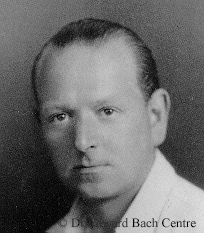Edward Bach(1886-1936)爱德华● 贝曲
内科医生
贝曲花精疗法发明人
Early medical career 早期医学生涯
Edward Bach studied medicine first in Birmingham and later at the University College Hospital, London, where he was House Surgeon. He also worked in private practice, having a set of consulting rooms in Harley Street. As a bacteriologist and pathologist he undertook original research into vaccines in his own research laboratory.
爱德华● 贝曲早期作为外科医生是在伯明翰大学和伦敦大学学院医院学习临床医学的。他也在私人诊所工作,并在伦敦的哈利街有一间咨询工作室。作为细菌治疗师和病理专家,他在自己的实验室从事着对疫苗的研究工作。
In 1917 Dr Bach was working on the wards tending to soldiers returned injured from France. One day he collapsed and was rushed into an operating theatre suffering from a severe haemmorhage. His colleagues operated to remove a tumour, but the prognosis was poor. When he came round they told Bach that he had only three months left to live.
1917年贝曲医生在从法国返还的伤病病房工作。一天,他突然晕倒,由于严重的肿瘤而被推入手术室。他的同事帮助他切除了肿瘤,但是预后并不是很好,他的同事们告诉他只有3个月的生存期。
As soon as he could get out of bed, Bach returned to his laboratory. He intended to advance his work as far as he could in the short time that remained. But as the weeks went by he began to get stronger. The three months came and went and found him in better health than ever. He was convinced that his sense of purpose was what saved him: he still had work to do.
贝曲医生刚能离床活动,便重返他的实验室。尽管只有很短的时间,但他依然坚持自己的探索研究。3个月过去了,他反倒更健康了。他更加坚信内心的目标挽救了他,他更加执着地坚持下去。
Homoeopathic research 关于顺势疗法的探索
His research into vaccines was going well, but despite this Dr Bach felt dissatisfied with the way doctors were expected to concentrate on diseases and ignore the whole person. He aspired to a more holistic approach to medicine. Perhaps this explains why, not being a homoeopath, he took the offer of a post at the Royal London Homoeopathic Hospital.
尽管贝曲医生的疫苗研究工作进展顺利,但他依然不能认同医生只关注疾病而忽略病人整体的观点,他追求一种更为全面的治疗方法。这或许就是他供职于伦敦皇家顺势疗法医院但却不是顺势疗法师的原因吧。
Once there he soon noticed the parallels between his work on vaccines and the principles of homoeopathy. He adapted his vaccines to produce a series of seven homoeopathic nosodes. This work and its subsequent publication brought him some fame in homoeopathic circles. People began to refer to him as 'the second Hahnemann'.
他发现了顺势治疗和疫苗之间的关联性,并将疫苗用于7种顺势疗法中,这项工作的后续结果为他在顺势疗法界带来很高的声誉,以至于有人称它为“第二个哈内曼”。
The flower remedies 关于花精
Up to now Bach had been working with bacteria, but he wanted to find remedies that would be purer and less reliant on the products of disease. He began collecting plants and in particular flowers - the most highly-developed part of a plant - in the hope of replacing the nosodes with a series of gentler remedies.
贝曲医生以至在为抗菌而工作,他希望找到更纯并且更少依赖于疾病产物的花精。他开始采集植物,尤其是植物最发达的部分-花朵,提取一系列柔和的花精。
By 1930 he was so enthused by the direction his work was taking that he gave up his lucrative Harley Street practice and left London, determined to devote the rest of his life to the new system of medicine that he was sure could be found in nature. He took with him as his assistant a radiographer called Nora Weeks.
他非常坚信他工作方向是正确的,到1930年他终止了在伦敦哈利街上获利颇丰的咨询室工作,而决定将他全部的生命都投入到寻找一种全新治疗方法中去,他坚信在不久的将来一定会找得到。和他一起工作的还有放射线技师Nora Weeks.
Just as he had abandoned his home, office and work, Dr Bach began to abandon the scientific method and its reliance on laboratories and reductionism. He fell back instead on his natural gifts as a healer, and more and more allowed his intuition to guide him to the right plants.
贝曲医生放弃了家、办公室和以往的工作,当然也放下了惯有的实验方法,他坚信自然界的疗愈能力,遵循内心意愿的引导找寻恰当的治疗植物。
Over years of trial and error, which involved preparing and testing thousands of plants, he found one by one the remedies he wanted. Each was aimed at a particular mental state or emotion. He found that when he treated the personalities and feelings of his patients their unhappiness and physical distress would be alleviated naturally as the healing potential in their bodies was unblocked and allowed to work once more.
经过了多年的摸索,走了数以千计的植物测试,他找到了一种又一种他所希望的花精。每一种花精都针对特定的情绪状态。他发现在面对客户的身心不愉快和低迷的时候,释放客户体内潜在的疗愈能力,治疗就自然而然地完成了。
His life followed a seasonal pattern from 1930 to 1934: the spring and summer spent looking for and preparing the remedies; the winter giving help and advice to all who came looking for them. Most winters were spent in the coastal town of Cromer. Here he met and became friends with a local builder and healer, Victor Bullen.
从1930年-1934年贝曲医生的生活有了明显的季节性印记,春夏季他寻找和收集花精,冬天则用花精治疗那些需要治疗的人们。大多数的冬季他都呆在Comer的沿海小镇上,在这里他也遇到了当地建设者和治疗师Victor Bullen ,并和他成为好朋友。
The Bach Centre 关于贝曲中心
In 1934 Dr Bach and Nora Weeks moved to a house called Mount Vernon in the Oxfordshire village of Brighwell-cum-Sotwell. In the lanes and fields he found the remaining remedies that he needed to complete the series. By now his body and mind were so in tune with his work that he would suffer the emotional state that he needed to cure and try plants and flowers until he found the one that would help him. In this way, through great personal suffering and sacrifice, he completed his life's work.
1934年贝曲医生和Nora Weeks 搬到了牛津郡的一个小镇上。在这里他发现了38种花精中剩余的部分并补充完整。这时,他的身心和工作是融为一体的,他为所承受的身心状态找到合适治疗的花精,正是通过这种自我忍受和牺牲的方式,他完成了一生追求的工作。
A year after announcing that his search for remedies was complete, Dr Bach passed away peacefully on the evening of November 27th, 1936. He was only 50 years old, but he had outlived his doctors' prognosis by nearly 20 years. He left behind him several lifetime's experience and effort, and a system of medicine that is used all over the world.
在他发表了完整的花精研究报告之后,1936年11月27日的晚上他安详地离去了。尽管他只活到50岁,但是就他的肿瘤预后而言,他多活了20年。他留下了宝贵的工作经验,这种疗法至今在全世界广泛地使用。
关键字:贝曲
花精


